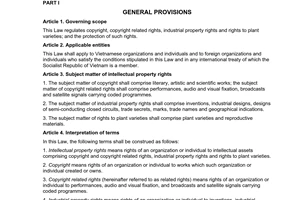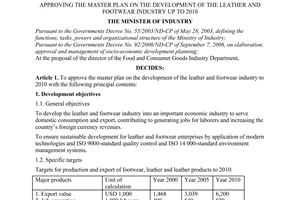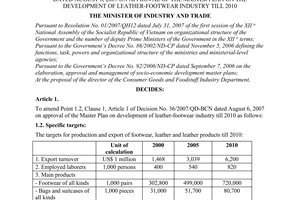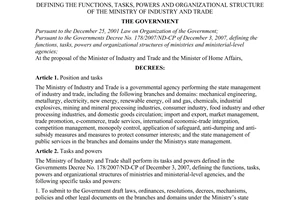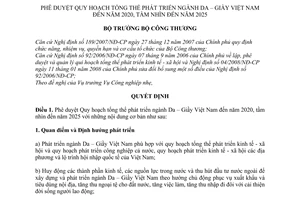Nội dung toàn văn Decision No. 6209/QD-BCT approving the master plan for the development
|
THE MINISTRY
OF INDUSTRY AND TRADE |
THE
SOCIALIST REPUBLIC OF VIETNAM |
|
No. 6209/QĐ-BCT |
Hanoi, November 25, 2010 |
DECISION
APPROVING THE MASTER PLAN FOR THE DEVELOPMENT OF THE LEATHER AND FOOTWEAR INDUSTRY OF VIETNAM BY 2020 AND THE ORIENTATION TOWARDS 2025
THE MINISTER OF INDUSTRY AND TRADE
Pursuant to the Government's Decree No. 189/2007/NĐ-CP on December 27, 2007 on defining the functions, tasks, powers and organizational structure of the Ministry of Industry and Trade;
Pursuant to the Government's Decree No. 92/2006/NĐ-CP dated September 07, 2006 of the Government on the establishment, approval, and management of the master plan for socio-economic development, and the Government's Decree No. 04/2008/NĐ-CP dated January 11, 2008, amending and supplementing a number of articles of the Decree No. 92/2006/NĐ-CP;
At the proposal of the Director of the Department of Light Industry,
DECIDES
Article 1. Approving the master plan for the development of the leather and footwear industry of Vietnam by 2020 and the orientation towards 2025. In particular:
1. Viewpoints and development orientation
a) Develop the leather and footwear industry of Vietnam in accordance with the master plan for socio-economic development, national industrial development, local socio-economic development, and the roadmap of international integration of Vietnam;
b) Mobilize the economic sectors, domestic resources, and attract foreign investment in developing leather and footwear industry of Vietnam to serve the export and domestic sale, increase the revenue of foreign currency, create employments, improve the incomes and life of employees;
c) Intensify the production of materials and ancillary industries that support the leather and footwear industry aiming to reduce trade deficit, raise added values, participate deeply in the added value chain of the world’s leather and footwear market;
d) Develop the leather and footwear industry of Vietnam rapidly and sustainably towards specialization, modernization, and application of new and modern technologies using advanced and eco-friendly apparatus, aiming to achieve high productivity and economic efficiency, to integrate into the regional and the world’s economy, to step by step converting from outsourced processing to proprietary production;
e) Combine the rapid development of production scale with the expansion of foreign and domestic markets; study and apply science and technologies; develop the trained human resources, especially poor and agricultural labor that participate in the economic restructuring from agriculture to industry. Combine the production development with the fulfillment of social obligation and environment protection. Move the facilities that process toe caps to rural areas and labor-abundant areas;
g) Develop the competence in designing and developing new products, prioritizing the application of automation to production and management;
2. Targets of development
a) General targets
Make the leather and footwear industry of Vietnam a key export industry by 2020. Remain one of the leading countries in the production and export of leather and footwear. Create more employments, increase employees’ income, fulfill social responsibilities, increase the number of trained workers
b) Specific targets
- The value growth rate of the leather and footwear industry reaches 9.4% per year during 2011 – 2015; 8.8% per year during 2016 – 2020; 8.2% per year during 2020 – 2025;
- Try to achieve the export turnover of 9.1 billion VND in 2015; 14.5 billion VND in 2020, and 21 billion VND in 2025. The growth rate of the average export turnover reaches 10.9% per year during 2011 – 2015; 9.7% per year during 2016 – 2020; 7.6% per year during 2021 – 2025;
- Gradually increase the proportion of domestic products. The proportion of domestic products reaches 60-65% in 2015; 75-80% in 2020, and 80-85% in 2025;
- Lead the fashion industry of Vietnam, together with the textile and garment industry, in some major cities;
- Build some industrial complexes and industrial parks of leather and footwear; produce materials and safeguard the environment by utilizing the existing infrastructure and labor, in order to actively supply the materials and raise the competitiveness;
- Build new and develop the training institutions, scientific and technological research institutions, laboratories, service centers, trade promotions centers, and fashion centers at home and overseas.
3. Development orientation
a) Plan for strategic products
- Footwear is the primary products of the industries. The production and export of sneakers must be prioritized;
- Produce high-quality bags, purses, satchels, wallets, and fashion leather footwear to serve high-end market and domestic market.
- Concentrate on producing leather using advanced and eco-friendly technologies serving the strategy to produce high-quality bags, purses, satchels, wallets, and fashion leather footwear to serve high-end market and domestic market. Invest in leather production and livestock to reduce trade deficit and to be more active in production.
- The average production and growth rate by 2020:
|
No. |
Products |
Unit |
2015 |
2020 |
|
|
1 |
Footwear |
Million pairs |
1,172 |
1,698 |
|
|
2 |
Bags, satchels, wallets, purses |
Million units |
170 |
285 |
|
|
3 |
Leather |
|
|
|
|
|
|
- Hard Leather |
1,000 tonnes |
39 |
63 |
|
|
|
- Soft Leather (30x30) |
Million pieces |
197 |
277 |
|
|
Average growth rate |
2011 - 2015 |
2016 – 2020 |
|||
|
1 |
Footwear |
% per year |
9.0 |
7.7 |
|
|
2 |
Bags, satchels, wallets, purses |
% per year |
13.0 |
12.0 |
|
|
3 |
Leather |
|
|
|
|
|
|
- Hard Leather |
% per year |
15.0 |
10.0 |
|
|
|
- Soft Leather |
% per year |
10.0 |
7.0 |
|
b) Planning by region
Arrange the development centers and producing capacity by region based on the advantages of man power, the resources of materials, and the traffic. Maintain and develop the existing centers of leather and footwear in major cities into shopping malls; design new models and technological services with high real-time; move the producing facilities, especially the facilities the process toe caps, to adjacent areas and labor-abundant rural areas.
The production and investment of the leather and footwear industry nationwide are arranged in 4 primary regions:
Region 1: the Red River Delta
Hanoi is the center of services, supply of materials, technologies, models and designs, facilities that produce footwear, bags, satchels, wallets, and purses with high value and reasonable scales, and the professional trade promotion centers.
The processing enterprises shall be developed or moved to provinces such as Hai Duong, Bac Ninh, the peripheral areas of Hai Phong city, Pho Noi (Hung Yen), Dong Van (Ha Nam), Nam Dinh, expanded Hanoi, Phu Tho, and Vinh Phu. These areas shall focus on providing materials and ancillary services; small industrial complexes, and trade villages. Develop training centers, and centers of scientific research, technology transfers and application.
Region 2: South East area
Ho Chi Minh city is the center of services, supply of materials, technologies, models and designs, facilities that produce footwear, bags, satchels, wallets, and purses with high value and reasonable scales, and the professional trade promotion centers; build small industrial complexes and trade villages in peripheral districts of the city. Move the leather facilities in the center and the periphery of the city to the concentration leather areas away from the city and residential area.
The facilities that production footwear, bags, satchels, wallets, and purses shall be moved to provinces such as Binh Duong, Dong Nai, Tay Ninh. Such area shall focus on providing materials and ancillary services. Develop training centers, and centers of scientific research, technology transfers and application.
Region 3: The North Central and Central Coast
Da Nang city is a center of the major industrial complexes of processing, and producing footwear, bags, satchels, wallets, and purses of the leather and footwear industry
The facilities making toe caps, producing footwear, bags, satchels, wallets, and purses, leather and foot wear made of crocodile leather and ostrich leather shall be developed in provinces such as Binh Dinh, Da Nang, Quang Nam, Khanh Hoa.
Region 4: The Mekong Delta
Can Tho city is the center. Encourage enterprises to expand the processing and production of footwear, and cooperate with local leather and footwear enterprises because of the advantage of human resources and incentives for economic restructuring.
Focus on Point the leather products, footwear, bags, satchels, wallets, and purses made of crocodile leather and python leather This is the advantage of the region recently by developing the largest area of reptile breeding in Vietnam.
(More details in Annex 1 promulgated together with this Decision).
4. Capital demand for developing the leather and footwear industry
- Total capital during 2011 – 2015 is 28,340 billion VND. Including:
+ Domestic investment: 12,340 billion VND, making up 44%;
+ Foreign investment: 835 million USD, making up 56%.
- Total capital during 2016 – 2020 is 31,230 billion VND. Including:
+ Domestic investment: 13,124 billion VND, making up 42% total investment;
+ Foreign investment: 944 million USD, making up 58% total investment.
- Total capital during 2011 – 2020 is 59,570 billion VND. Including:
+ Domestic investment: 43%
+ Foreign investment: 57%
(More details in Annex 2 promulgated together with this Decision).
5. Solutions for implementation
a) Investment solutions
Keep utilizing the investment in the leather and footwear industry from developed countries; combine investment and integration; participate in international division of labor to facilitate the development and production expansion.
Mobilizing all capital sources from all economic sectors, under various form of ownership, at home and overseas, to build and develop more production and business establishments.
Encourage the development of medium and small enterprises and trade villages. Encourage the commencement of leather and footwear enterprises that create many employments and hire existing labor in rural areas.
The investment must ensure both rapid expansion of the production scale and capacity, and the restructuring of the industry towards sustainable development and increasing efficiency. Some primary projects of investment:
- Invest in expanding more 3,000 of production lines of toe caps, and projects of producing bags, satchels, wallets, and purses These projects of investment must be executed in rural areas and labor-abundant areas.
- Invest in new and expand more than 400 lines of footwear assembly. These projects of investment must be executed in provinces that have advantages of seaports and materials;
- Invest in new and develop the fashion survey centers in major cities; centers of assessing quality of materials and products; the projects of investment in waste treatment sites and environment protection;
The projects of producing leather and footwear materials; projects of investment in industrial parks and industrial complexes of leather and footwear materials shall enjoy incentives as ancillary industries, and enjoy incentives for investment credit and export credit from the State;
The State shall consider and allocate land for developing industrial parks and industrial complexes of leather and materials; develop the centers of leather and footwear materials; the centers of training, scientific research, technology transfer and application, model design; test labs and concentrated environment treatment sites of the industry.
b) Solution for developing the material production and ancillary industries.
Encourage the concentration of resources so that the leather and footwear industry may actively aim for the export and increase the value chain of leather and footwear. Prioritize the expansion of: products design and development, material production, and product inspection and certification. The investment in 3 disciplines above is to increase the value and competitiveness of Vietnam’s footwear, bags, satchels, wallets, purses, and leather; balance the materials in production, reduce cost, and control the product origins by intensively producing domestic products. Some primary projects:
- Build 02 centers (01 in the south, 01 in the north) of providing materials and ancillary services, in order to make a breakthrough of leather and footwear ancillary industries.
- Expedite the construction of 02 concentrated leather industrial parks/industrial complexes (01 in the south, 01 in the north) that have a waste treatment system to satisfy the demand for leather at home and for export, reduce the import, and increase the proportion of domestic products.
- Expedite the projects of building fashion research centers and leather and footwear development centers in Hanoi and Ho Chi Minh city;
- Encourage enterprises to study and produce machinery and equipment serving the industry development to reduce trade deficit.
c) Solution for the market
In order to sustain, expand the export market, and gradually break into the domestic market, the leather and footwear industry must be developed based on its efficient and active production capacity, under the management of business people experienced in international fashion. In particular:
- Sustain the primary products (sneakers) and traditional markets (US, EU, Japan) together with actively and flexibly innovate the structure of producing exports, in order to satisfy the diverse of the market, especially the export market;
- Study to give early warnings about the liability to imposition of penalties for subsidies and dumping in order to avoid litigation when participating in the world's market. Apply the commercial protection measures for dumping and intellectual property to protect the domestic production and consumers;
- Enhance the trade promotion via the National trade promotion program aiming to sustain traditional export markets (US, EU, Japan, and) and develop new markets (Middle East, Africa, SNG, Asia). Regularly hold fairs and exhibitions at home and overseas to provide enterprises with opportunities to advertise and introduce their products to consumers nationwide and foreign investors who look for a chance to produce or trade leather and footwear in Vietnam;
- Produce leather and footwear with appropriate prices, quality, and designs that suit the taste and habit of Vietnamese consumers. Develop and expand the product distribution system of domestic enterprises to rural areas and highlands. Support and participate in the movement “Prioritize products made in Vietnam”;
- Cooperate with the textile and garment industry in building a number of fashion centers and shopping malls in major cities and economic centers;
- Actively approach the modern business skills, prioritizing the development of trademarks and brand names, in order to present the image of Vietnam’s leather and footwear to domestic and international markets.
d) Solution for training the human resources
By 2020, prioritize the training of human resources to create a resource for converting the method of production, improve the quality of human resources able to participate in international production and business on the basis of achieving the social potential and generating motivation for developing the industry, and the extensive mechanism of socialization. In particular:
- Cooperating with schools of the Ministry of Industry and Trade and other training institutions in building some training centers specialized in leather and footwear industry that meet the National standards that adopt the method of socializing education and training;
- Build a training system by in the cooperation of the State - the school - and the corporations;
- Build a complete vocational module according to the segments of the added value chain of the leather and footwear industry (design, production, sale) aiming to create a training database for training institutions, and enterprises may base on that to train human resources that suit their requirements, shorten the distance between theory and practice, create favorable conditions for enterprises to retrain and enhance the proficiency of workers;
- Boost and expand international cooperation in training to build and improve the qualified human resources that are comparable to that of develop countries, and may deeply penetrate the international market.
- Encourage all economic sectors and forms of enterprises at home and overseas to contribute in the investment in the training of the leather and footwear industry.
- The State shall cover of the expense from the budget and other projects of supporting economic development at home and overseas for the research, training, and investment in technical facilities, aiming to raise the capability of research institutes and training institutions of the leather and footwear industry;
- The Vietnam Leather & Footwear Association and the Leather and Footwear Research Institute must cooperate with vocational schools in opening training class for the managers, designers, technicians, and salespeople; combine short-term and long-term training; combine formal training and on-the-spot training, training at home and training abroad;
e) Solution for the development of science and technology, and environment protection
- Expand and improve the capability of leather and footwear research institutes towards autonomy, so that they can become focal units in studying, applying new technologies and materials, training human resources, and participating in planning strategy for the development of leather and footwear industry;
- The State shall encourage enterprises to invest in scientific research and applying advanced and modern technologies in their production via trading and technology transfer with countries of which the leather and footwear industry is developed;
- Study the treatment of wastes in form of solid, liquid, and gas from the processing and production of leather and footwear applying advanced and eco-friendly technologies;
- Build a database of international and Vietnamese shoe sizes; build a database of leather and footwear industry and the system of technical and artistic module of footwear production;
- Build 2 centers of analyzing materials, products, and environment of the leather and footwear industry in Hanoi and Ho Chi Minh city;
- Boost the international cooperation and encourage the domestic creation in scientific research in order to create advanced technologies for the industry, on the basis of expediting and executing some science and technology projects that suit each development stage of the industry.
f) Solution for the industry management
- The State must continue the administrative reform, concentrating on completing and simplifying administrative procedures for investment, export, import, customs, and tax refund, in order to attract investment and reduce cost for enterprises;
- Enhance the role and efficiency of the Vietnam Leather & Footwear Association, on the basis of effectively creating the connection among the leather and footwear enterprises, between leather and footwear enterprises and the Government (the Ministry of Industry and Trade). The Association must represent the enterprises, settle the shared issues of the industry, collect opinions and proposals from leather and footwear enterprises and sent to the Government or the Ministry of Industry and Trade, aiming to build a legal corridor for the sustainable development of enterprises in accordance with Vietnam’s law and international law;
- Formulate technical standards and Vietnam’s Standards of leather and footwear industry to satisfy the requirements for international integration in accordance with Vietnam’s law;
- Intensify the inspection and supervision of the implementation of the Law on Intellectual property, the Law on Trade, and take the commercial precaution measures for ensuring the interests of consumers and enterprises.
Article 2. Implementation organization
1. The Ministry of Industry and Trade shall be in charge and cooperate with relevant Ministries, industries, and People’s Committees of central-affiliated cities and provinces in directing the development of the industry in accordance with this plan, and announcing this plan;
2. The Ministry of Planning and Investment, the Ministry of Finance, the Ministry of Agriculture and Rural development, the Ministry of Science and Technology, the Ministry of Natural Resources and Environment, the Ministry of Education and Training, the State bank of Vietnam, and the Vietnam Development Bank must cooperate with the Ministry of Industry and Trade in supporting enterprises and localities in implementing the Plan and approved schemes.
3. People’s Committees of central-affiliated cities and provinces must concretize the master plan for developing the leather and footwear industry locally, and cooperate with Ministries and industries in supervising the implementation of the plan to ensure the uniformity with the master plan for local socio-economic development.
4. Vietnam Leather & Footwear Association must cooperate with the Ministry of Industry and Trade in propagating and disseminating this plan to leather and footwear enterprises nationwide in order to have an orientation and plan for production and business development in accordance with the plan. Collecting opinions and proposals from enterprises and send to competent agencies to adjust the plan to suit the actual situation.
Article 3. This Decision takes effect as from the date of its signing.
Article 4. Ministers, Heads of ministerial-level agencies, Heads of Governmental agencies, and People’s Committees of central-affiliated cities and provinces and relevant agencies are responsible for implementing this Decision./.
|
|
THE MINISTER |
ANNEX 1
STRUCTURE OF PRODUCITON BY REGION
(Promulgated together with the Decision No. 6209/QĐ-BCT dated November 25,
2010 of the Ministry of Industry and Trade)
|
Primary products |
Region 1 |
Region 2 |
Region 3 |
Region 4 |
|
Structure of production by region in 2010 |
||||
|
1. Footwear (%) |
10 |
79 |
6 |
5 |
|
2. Leather (%): - Hard Leather - Soft leather |
3 |
92 |
2 |
3 |
|
3 |
91 |
3 |
3 |
|
|
3. Bags, satchels, wallets, purses (%) |
7 |
84 |
4 |
5 |
|
Structure of production by region in 2015 |
||||
|
1. Footwear (%) |
12 |
72 |
9 |
7 |
|
2. Leather (%): - Hard Leather - Soft leather |
5 |
84 |
5 |
6 |
|
5 |
84 |
6 |
5 |
|
|
3. Bags, satchels, wallets, purses (%) |
8 |
83 |
4 |
5 |
|
Structure of production by region in 2010 |
||||
|
1. Footwear (%) |
14 |
67 |
10 |
9 |
|
2. Leather (%): - Hard Leather - Soft leather |
7 |
79 |
6 |
8 |
|
7 |
79 |
7 |
7 |
|
|
3. Bags, satchels, wallets, purses (%) |
8 |
82 |
5 |
5 |
Region 1: the Red River Delta
- Including: Hanoi, Bac Ninh, Vinh Phuc, Quang Ninh, Hai Duong, Hai Phong, Hung Yen, Thai Binh, Ha Nam, Nam Dinh, and Ninh Binh.
- Hanoi is the center.
Region 2: South East area
- Including: Binh Phuoc, Tay Ninh, Binh Duong, Dong Nai, Ba Ria – Vung Tau, and Ho Chi Minh city.- Ho Chi Minh city is the center.
Region 3: The North Central and Central Coast
- Including: Thanh Hoa, Nghe An, Ha Tinh, Quang Binh, Quang Tri, Thua Thien Hue, Da Nang, Quang Nam, Quang Ngai, Binh Dinh, Phu Yen, Khanh Hoa, Ninh Thuan, and Binh Thuan;
- Da Nang city is the center.
Region 4: The Mekong Delta
- Including: Long An, Tien Giang, Ben Tre, Tra Vinh, Vinh Long, Dong Thap, An Giang, Kien Giang, Can Tho, Hau Giang, Soc Trang,Bac Lieu, and Ca Mau;
- Can Tho city is the center.
ANNEX 2
LIST OF PROGRAMS AND PROJECTS OF INVESTMENT BY 2015
(Promulgated together with the Decision No. 6209/QĐ-BCT dated November 25, 2010
of the Ministry of Industry and Trade)
1. Projects of ancillary industries
The State shall encourage the investment in the production of materials and ancillary industries of the leather and footwear industry. The projects of producing leather and footwear materials; projects of investment in industrial parks and industrial complexes of leather and footwear materials shall enjoy incentives as ancillary industries, and enjoy incentives for investment credit and export credit from the State; New projects:
- Project of investment in producing PU-coated leatherette that reaches 20 million m2 per year, estimated investment is 210 billion VND;
- Project of investment in producing materials for footwear, bags, satchels, wallets, and purses, estimated investment is 450 billion VND;
- Project of investment in producing molds and blades, estimated investment is 500 billion VND;
- Project of investment in producing shoe lasts, estimated investment is 200 billion VND;
- Project of investment in producing finished leather that reaches 25 – 30 million pieces per year, estimated investment is 1,600 billion VND
2. Projects of building the infrastructure of industrial parks, industrial complexes, and waste treatment
The project of investment in environment protection for the leather and footwear industry in industrial parks, industrial complexes, and factories are eligible for preferential loans from environment protection funds, ODA, or investment and development fund. The new projects:
- Project of investment in building a concentrated waste treatment site for leather production (not including waste burial) that reaches 600 tonnes per day, estimated investment is 700 billion VND;
- Project of investment in building a concentrated waste treatment site for production of footwear, bags, satchels, wallets, and purses, that reaches 600 tonnes per day, estimated investment is 700 billion VND;
- Project of investment in building a center of developing environmental technologies of leather and footwear industry, estimated investment is 200 billion VND.
- Project on industrial parks and industrial complexes of footwear and materials in the north (region 1), estimated investment is 350 billion VND;
- Project on industrial parks and industrial complexes of footwear and materials in the south (region 2), estimated investment is 350 billion VND;
- Project of investment in industrial parks and industrial complexes of leather and footwear industry, estimated investment is 1,000 billion VND.
3. Projects of science, technology, and training for human resources
The projects of investment in development of science and technology, the projects of investment in developing human resources, the projects of product research are partly funded by the State. The new projects:
- Investment in of leather and footwear research institutes, estimated investment is 100 billion VND.
- Investment in building 2 centers of analyzing materials, products, and environment, estimated investment is 100 billion VND;
- Project of building a database of leather and footwear industry: 20 billion VND;
- Project of building a database of leather and footwear industry: 30 billion VND;
- Project of building vocational schools and training modules for the leather and footwear industry: 250 billion VND.
4. The projects according to the socialization mechanism
The projects of building trade promotion and services centers are executed according to the socialization mechanism Prioritize the construction of fashion centers in Hanoi and Ho Chi Minh city. The capital is raised from domestic and overseas sources The new projects:
- Building trade promotion centers and fashion centers in Hanoi and Ho Chi Minh city; estimated investment is 200 billion VND.
5. Projects of attracting foreign investment
The new project of investment aiming to increase the productivity, expand the scale and diversify the products, provide materials and ancillary services The new projects:
- Investment in new projects of material production and ancillary industries: 1,200 billion VND.
6. The national programs for developing the industry
- The National trade promotion program, estimated budget: 50 billion VND;
- The National Industry support program, estimated budget: 25 billion VND;
- The national trademark development program: 25 billion VND.
---------------------------------------------------------------------------------------------------------------------------------
This translation is translated by LawSoft, for reference only. LawSoft is protected by copyright under clause 2, article 14 of the Law on Intellectual Property. LawSoft always welcome your comments.
------------------------------------------------------------------------------------------------------
This translation is made by LawSoft and
for reference purposes only. Its copyright is owned by LawSoft
and protected under Clause 2, Article 14 of the Law on Intellectual Property.Your comments are always welcomed

